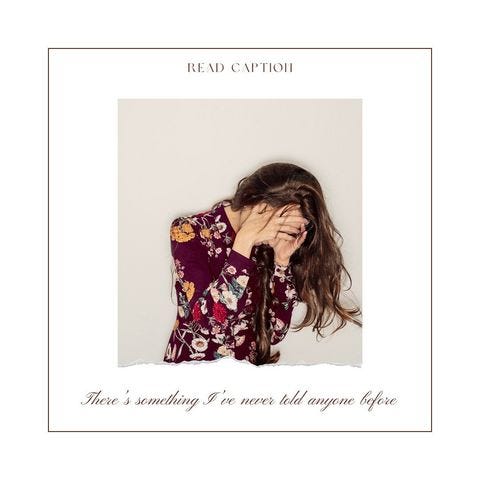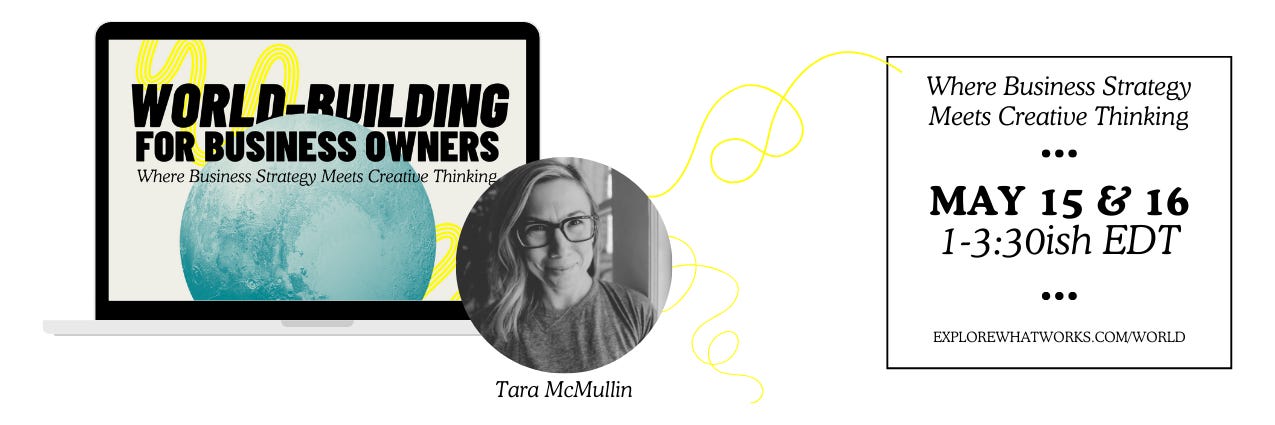The Many Hats of Leigh Stein
The identity we perform in digital spaces is ours to play with—we might as well enjoy the show.

Like many artists and creatives,
wears many hats. She's a novelist, poet, cultural critic, book coach, and publishing expert. When you wear many hats, who you think you are and who other people think you are can easily diverge. You might become more known for one identity while another identity fades into the background.Leigh noticed that her Instagram audience had come to think of her as a book coach and publishing expert rather than as a novelist. However, Leigh wanted to use Instagram to build an audience of readers, so she needed to do some identity management.
"So, what I did, at the end of December of last year, is announce that I would be leaving book publishing and accepting a job at Richual, the wellness company," she told me in an interview. Richual, however, isn't a real company. And Leigh didn't actually decide to leave the publishing industry.
This was, as Leigh put it, "digital performance art."
When I discovered Leigh's project back in January, I thought it was remarkable. Leigh revealed the project to her Substack audience in a post titled "autofanfic," which is how I learned about it. Because you see, Richual isn't a real company—but it really is the company at the center of Leigh's 2020 satirical novel, Self Care.
In other words, Leigh decided to perform on Instagram as if she were a character in the world she created for her novel. It was an opportunity to create something funny and engaging while also managing her identity. "When I think about my future obituary," she told me, "I want it to say ‘Leigh Stein wrote funny books.’"
How we manage, perform, and play with identity in online spaces gets to the core of any discussion of the creator economy. And so today, I want to explore the question:
What if we embraced our online identities as works of performance art?
Identity Is Performative
Identity is performative. According to many theorists, our speech, presentation, and actions produce (and reproduce) our identities. The way those performances are received by others also produces our identities.
This idea might be best known today through Judith Butler's work on gender. In their groundbreaking 1990 book Gender Trouble, Butler argues that the concept of gender is socially constructed. We come to understand our gender identities through social means.
...we get a sense like, 'oh, this is acceptable to do things this way.' And there are certain kinds of punishments waiting for us if we don’t do them the right way. So, I think there’s an anxiety about making sure we appear a certain way or talk the right way or even laugh the right way.
And the way in which we assume a gender, I mean, take it on and embody it—I think that happens through a series of repetitions. We enact it. We enact the norms and the norms work because we enact them ... we learn how to act a certain way over time, and we get better at it, or worse at it, or we play with it, or we find ourselves changing the terms in the middle of the script.
—Judith Butler, in an interview with MSNBC's Chris Hayes
A person who wears their hair long, puts on makeup, and dons a pink dress is likely to be perceived as a woman, because through socialization, that’s how we’ve learned to perceive. And because the category of "woman" is associated with certain characteristics like affection, gentleness, and sensitivity, that person will likely be treated as if they possess those characteristics. That person, in turn, learns to enact those characteristics. Performativity is a reinforcing feedback loop.
Identity is always already entangled in the social conditions that make it. We can’t detangle an essential self from those conditions.
The same is true for any other identity—which doesn't negate material descriptions of a person. It simply means that those descriptions don't define us. Identity isn't something I am. And it's not something you tell me I am. Identity is the dance between the two perspectives.
So when Leigh realized that her Instagram followers were perceiving her as a book coach and publishing industry expert rather than a satirist, she decided to orient her performance to the identity she wanted others to receive her as.
Keep reading or listen on the What Works podcast.
Leigh Doubles Down
After Leigh announced her departure from the publishing industry with her tongue in her cheek, she realized just how few of her Instagram followers had read her book (or were even paying attention to the fact that she'd written a book that satirizes the wellness industry).
The next day, she doubled down. Her next post radiated that wellness industry glow. She shared how proud she was to work for a women-centered company that made colonic hydrotherapy a prerequisite of employment. "Me talking about my colon on Instagram," she exclaimed, "what weirder thing could I do?"
Leigh wanted to make it easy for people to spot that this was all satire. "I was really trying to put a banner in the sky, 'This is a joke!' But even then, a famous influencer commented and said with real concern, 'Leigh, you might be in a cult.'"
In a TikTok video, Leigh observes that the tendency to take works of art very seriously and earnestly (as if they are 'authentic') proliferates through social media platforms. She attributes this to the "flattening" effect of social media on discourse. I agree—but I'd also add that so much of social media is the absurd appearing familiar. The reason people didn't get the joke about Leigh's company-mandated colonic is that, while absurd, it's no more absurd than half of what we see on social media. And it's certainly no more absurd than many of the circumstances of labor under capitalism.
I digress. Let's talk about Canva!
"I'm not a designer," Leigh tells me, "but I just started using Canva [templates]." Canva does indeed provide a wellness industry satire start kit. They don't call it that, but if I wanted to spoof the wellness industry (or the online business sector, or self-help culture, etc.), that's the first place I would go.
One of my favorite posts from Leigh's Canva period is a carousel of 'aesthetic' images featuring women covering their faces. Each image features the text, "There's something I've never told anyone before." In the caption, she writes, "I have chills typing this. I can’t believe I’m about to share this with my 262,000 followers but I believe in standing in my truth, so here goes:"
That's it. That's the post.
And no, she does not have 262,000 followers.
After about two months, Leigh decided it was time to wrap up the project. Of course, she wanted to go out with a bang. And she wanted to sell books.
"I decided to say that I had been fired," she explained, "and I though, 'What could I be fired for? Oh, I'll get fired for speaking about my employer-mandated colonic hydrotherapy!'" So she made the climactic video: a Reel staged in her car as if she'd just gotten out of a meeting with human resources.
Since this was the first Reel she posted after archiving all of her previous content, Instagram gave the video a little boost. The engagement took it from there. When we talked, the video had been viewed nearly 800,000 times and had nearly 14,000 likes.
"In the video, I say, 'How could I be fired? I have freedom of speech, and I can talk about my squeaky colon if I want to!" she explained. Of course, any mention of freedom of speech comes with a large side of mansplaining about what is and is not covered under freedom of speech. The upside is that brought Leigh's video even more views and engagement.
Provocation and Performance
As Leigh said at the top, this is digital performance art.
Leigh intentionally constructed her autofanfic to perform her critique of the wellness industry, influencer culture, and social media marketing—and by performing that critique, she was also performing her chosen identity.
Western modernist and postmodernist performance art developed in Europe and the US in the mid-20th century.1 According to Sarah Urist Green, a curator and host of The Art Assignment, "Performance art was born of a desire to flatten the hierarchy inherent in traditional art forms so that the artist could reach an audience directly."
RoseLee Goldberg, a scholar of performance art, asserts that "provocation is a constant characteristic of performance art, a volatile form that artists use to respond to change ... and to bring about change." Satire functions similarly in that it provokes its audience by exposing the absurdity of something or someone.
What I love about Leigh's project is that it exposes the performance at the heart of all social media content. Social media invites provocation and response. And while that tendency can certainly be abused and become harmful, it's also a creative opportunity.
We've been coached to put our "real selves" into the content we create. Authenticity is attractive, they tell us. But we know our "real selves" and our authentic sharing is mediated through platform logics and algorithmic distribution. We know that the experience of "being ourselves" in these digital spaces is often alienating and objectifying.
So what if, like Leigh, we just embraced the performance? What if we accept that the identity we perform in digital spaces is ours to play with?
That doesn't mean we can't be smart or strategic about it. Just that we use the constraints and incentives of the platforms we inhabit to our own advantage. We use them as tools for performing the identity we choose—and achieving the objectives that are important to us.
And that brings us to the end of the story.
The Bait and Switch
After she made the Reel about being fired, Leigh announced that she'd been contacted by literary agents. They wanted to know if she was interested in writing a memoir about her time at Richual. "Then, I said no, I've been advised by my legal team that it would be too risky to a memoir." Instead, Leigh would write a novel.
Using her real Publishers Marketplace announcement for Self Care, she posted that she sold the book. Again, followers congratulated her! Even, she recalled, "women who've known me for seven years, who've known me through the entire time the book has been out."
The only thing left to do was confess.
"I went on camera. I confessed. I talked about what the prank was. I talked about what the book is." Leigh told me that it had been enough time that she could see her digital performance art project did indeed move books. "I have seen a bump in sales."
Witness To and Participant In
Sarah Urist Green, the curator I mentioned earlier, described one performance art piece this way:
Guests arrived with little idea of what would happen—both witness to and participant in loosely structured actions.
That could easily describe what happens any time we open a social media app. We arrive in the feed with little idea of what we'll encounter, and we become both witness to and participant in the haphazard, algorithmically generated order of content.
"It's participatory," she explained, "It's not just the audience watching me on camera, it's that they're playing along in the comments section." Not only do they respond, the audience also participates by giving her new ideas for videos through their own questions and observations.
"I still find [the internet] like a playground," Leigh told me, "I like trying things and goofing around." While others view social media as "drudgery," Leigh wants whatever she does online to be playful. And she wants her audience to play with her.
The audience is an integral part of her performance and her strategy.
Talking to Leigh, I realized that one of the things that really makes her social media strategy work—and I don't just mean work in terms of commercial gain, but work in terms of how she performs her identity without the psychological stress so common to personal branding—is the way she is cognizant of who she's performing for and what sort of feedback she wants from them. In fact, her performance of identity requires an audience to realize its full potential.
And that leads us to Leigh's other identities and how she performs them on other platforms for different audiences.
Different Platforms, Different Performances
Leigh has built three distinct audiences: one on Instagram, another on TikTok, and yet another on her Substack,
. While there is certainly overlap in who is in the audiences, the social relation between the audience and Leigh is different because she's performing a different identity on each platform."I think about what audience I am trying to reach and for what," Leigh explained. On Instagram, she wanted to pivot from her book coach identity to her satirist identity. But on Substack, she does perform the book coach identity. On TikTok, she wants to build an audience of readers, so she's performing an "aging Millennial" BookToker identity.
Her TikTok performance helps her build a platform for her existing books, but it's also her "method acting" for a novel she's currently writing about TikTok content creators.
Theorist Roland Barthes argued that the reader participates in creating the meaning of a text. The author puts their own interpretation onto the page (or the performance) but that text remains open and malleable. The reader's interpretation is as much a part of the art as the author's.
In the realm of social media, the content creator injects their own identity performance into the content they create and share. However, the meaning of that identity is not fixed. The viewer's interpretation is crucial, as it provides the feedback that refines and reinforces the performance—echoing Butler's theory of gender performance. This interactive dynamic between creator and viewer is a key aspect of social media's influence, for better or worse, on identity.
Unlike traditional publishing, where an author or filmmaker releases a completed text and the audience receives it, social media operates in a continuous loop. Texts are published, received, and then refracted back to the creator through the audience's action. This ongoing process creates an artifact of identity that is perpetually evolving and only ever partially formed.
The ongoing nature of the performance often causes tension for the content creator when the performance itself is ambiguous—that is, when we're not quite clear on who we're trying to be, what we stand for, and who our performance is for. Ambiguity is unavoidable if you're trying to "be real" on social media—because we are many different selves, capable of authentically performing many identities. Leigh's approach offers a different way forward.
By being strategic with her social media performance, Leigh removes much of that ambiguity. That doesn't make her media less social. Rather, her tact gives the audience more to work with. She invites the audience into the social construction of her identities in a more productive way.
That said, it's important to remember that social media platforms are not peer-to-peer; they are peer-to-machine-to-peer, as I argued in an earlier piece. Leigh's approach to creating content and socially constructing her work and artist identities is still subject to the machine. How the machine mediates her performance can be frustrating she admits.
She chooses to keep playing, despite this often confounding aspect of the game. As long as she's having more fun than frustration, it seems like a smart trade-off.
Leigh's sentiment here echoes the great RuPaul:2
Once I studied the way society is and how people put on these roles, I realized it was all a game. It was all an illusion. So you know what? I'll have fun with the illusion.
Leigh is having fun with the illusion. And I think that might be the healthiest approach to social media and the creator economy that I've heard yet.
Performance art has a long history outside of the West and contemporary period. Today’s piece is situated in this much narrower definition and history of the art.
Drag is another sphere in which self-aware identity performance (play) is used for both fun and provocation. I almost made this whole piece about social media as drag…








